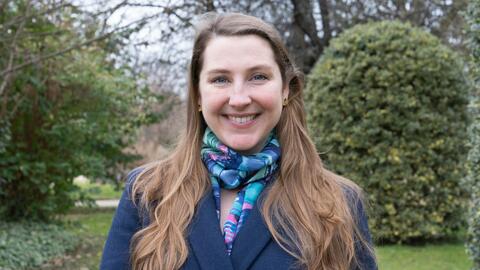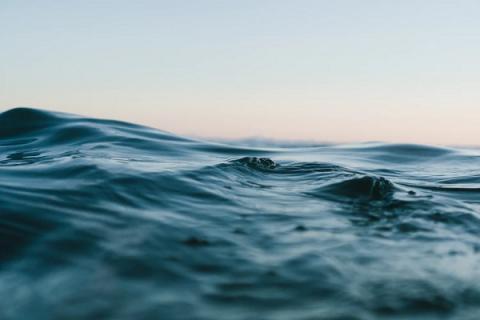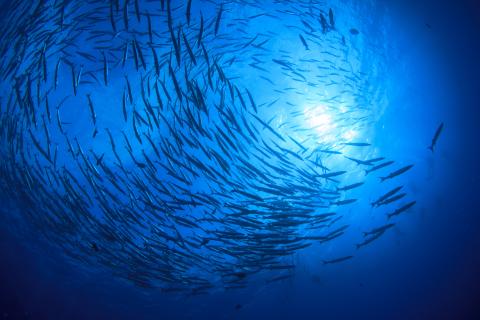
Into the deep with Dr. Katherine Hutchinson: From Antarctic expeditions to cutting-edge climate research
For Dr. Katherine Hutchinson, a lifelong pull toward both the ocean and France unexpectedly converged. Growing up in Cape Town, surrounded by three oceans, she was captivated by the sea’s power, while a love of the French language—sparked in high school—eventually led her to France. Now based in Paris, she juggles life as a physical oceanographer, ocean modeler, and project manager for NEMO, merging her passion for ocean exploration with cutting-edge climate research.
You’ve had such a fascinating career in oceanography. What drew you to the field in the first place?
Dr. Katherine Hutchinson: I grew up in Cape Town, South Africa, surrounded by the ocean—three oceans, actually: the Atlantic, the Indian, and the Southern Ocean to our south. My dad was an old surfer, so my connection with the sea came through him. I prefer swimming—especially being in the waves, letting them crash over me. For me, that’s where it’s at. That feeling of surrendering to the power of the ocean is something that’s always stuck with me.
I didn’t even know oceanography existed as a discipline until high school, when climate change started getting more attention, though most of what you’d see was about polar bears and melting ice caps. I had a great French teacher who let us choose any topic for our oral exams, as long as we spoke in French, and I always chose to talk about environmental science and climate change. That freedom to explore environmental topics planted a seed, and my fascination with the ocean grew from there.
Then I went to the University of Cape Town’s open day. I was at the environmental science kiosk, and right next door was the oceanography lab. That was it for me—I was sold. Later, during my second year, a lecturer showed us a video of a student expedition to Antarctica. I saw that and thought, "That’s going to be me!"
And was it? Did you make it to Antarctica?
KH: I did! After finishing my undergraduate degree, I was offered one of four spots on the South African icebreaker, the SA Agulhas, on its last Antarctic expedition. I turned 21 on the ship—a real coming-of-age moment—on my way to Antarctica.
As for the work, I was basically a dogsbody: helping with water sampling and equipment deployment, but it was incredibly inspiring. I spent three months at sea on an old rust-bucket icebreaker. My mom was terrified! She stood on the dock crying as the ship left. There was no Wi-Fi back then—just emails sent through the ship’s radio officer. You had to hand him a flash drive with your email on it, and he’d send it out when he could. It was a whole system!
That experience inspired me to pursue oceanography seriously. I specialized in it for my master’s, completing a collaborative degree between the University of Cape Town and the Université de Bretagne Occidentale in France. That connection came full circle because of my high school French classes. In a way, it was perfect—combining my love for the ocean and my passion for French.
It sounds like you’ve had a really hands-on career so far. How did those early experiences shape your approach to science?
KH: They really taught me the value of observation and data. When you’re at sea, you’re often working with limited information and trying to make sense of what you’re seeing in real time. It’s very different from sitting behind a computer with all the data laid out in front of you. I learned how to problem solve quickly, adapt to changing situations, and trust the data we were collecting.
I also learned a lot about teamwork from life aboard the ship. Emotions can run high when you’re out at sea for weeks, working long shifts, so learning to navigate those dynamics is just as important as the science. You also learn not to take yourself too seriously—there are always funny moments when you’re stuck with the same people in close quarters.
How did you transition from physical oceanography to becoming an ocean modeler?
KH: My early career focused on expeditions—eight in under eight years. I turned 21 on my first trip and 29 on my last. My final expedition was as the physical oceanography lead for the Weddell Sea Expedition on South Africa’s new icebreaker the SA Agulhas II. We were searching for Endurance, Ernest Shackleton’s lost ship. We weren’t the ones who found it, but the experience was incredible. After that, I shifted focus. Observations at sea are fantastic, but they’re limited—you only get one point in time and space. I wanted to fill in the gaps with ocean models.
Ocean models are powerful tools. They simulate how the ocean moves and changes using mathematical equations. Think of it like breaking the ocean into little Lego blocks—each block represents a section of the ocean with information being passed between the blocks and the solution for the mathematical equations being solved for each step in time. Models can use past data to simulate historical ocean conditions and use various scenarios to predict future changes, which is crucial for climate change projections. It felt like the natural next step—combining the observations I loved with the bigger picture provided by modeling.
That sounds like a huge leap in your career. How did you end up managing NEMO?
KH: It was a leap! I did a postdoc in ocean modeling at Sorbonne University, where I learned the basics of modeling from Julie Deshayes. Initially, it was intimidating because I had no background in coding or modeling. Then, during my Marie Curie (MSCA) postdoc, the project manager for NEMO retired. I’d always loved teamwork on expeditions, and research felt lonely in comparison. So, I applied for the position.
NEMO is a consortium of five institutions across three countries, with about 30 developers working on ocean modeling. My role is to coordinate them all, ensure the model runs efficiently on high-performance computers, and communicate updates to the broader community. It’s a lot of collaboration, conflict resolution, and translation—turning complex coding jargon into something intelligible for a “normal” human!
I know you’re currently focused on ocean-ice shelf interactions. What’s the biggest challenge with this research?
KH: The biggest challenge is that we have a very limited idea of what’s really happening under the ice shelves. These are the floating margins of the Antarctic ice sheet with vast cavities beneath them. We can’t see under the ice shelves from space, and we can’t get there with ships. Even robots struggle—they lose signal signal, and it’s completely dark. We’ve used seals with sensors attached to their heads to gather data under sea ice, but they don’t dive deep enough to reach under the ice shelves. Validating our models is tough when we can’t directly observe what’s happening.
That must also be exciting— potentially solving a mystery!
KH: Exactly. It’s both frustrating and exciting. We’re working towards better observational tools while improving our models to simulate these unknown areas. It’s a race to understand how ocean-ice shelf interactions affect the broader climate and how these processes will evolve under climate change.
Why do you think international collaboration is important in ocean science?
KH: Definitely! Different countries train scientists in different ways, which brings fresh perspectives. In South Africa, our education is multidisciplinary—we learn a bit about everything, which makes us adaptable but not deeply specialized. In France, the focus is on deep specialization in one field. Collaborating internationally results in the best of both worlds. It encourages creative problem solving and helps us avoid getting stuck in the same patterns of thinking.
Finally, what’s one thing you wish more people knew about the ocean?
KH: I wish people understood the scale and importance of the ocean’s movement. Most people stand on a beach and see waves and tides, but there are massive currents moving heat and salt around the planet, regulating our global climate. The Gulf Stream, for example, keeps the ports of northern Europe ice-free. The ocean is the planet’s bloodstream, sustaining it and fueling it with energy, but its vast movements remain invisible to most people. I’d love to find better ways to show that visually—through graphics, for example—so everyone can appreciate its power.
And it’s not just the large-scale currents that matter. Even small changes in temperature and salinity can have a huge impact on marine ecosystems and, ultimately, on human life. Understanding and protecting the ocean is essential if we want to address climate change effectively.
The ocean is so key to our lives in ways we aren’t aware of— it’s sad to think that some of us are missing out on the ocean’s wow factor.


